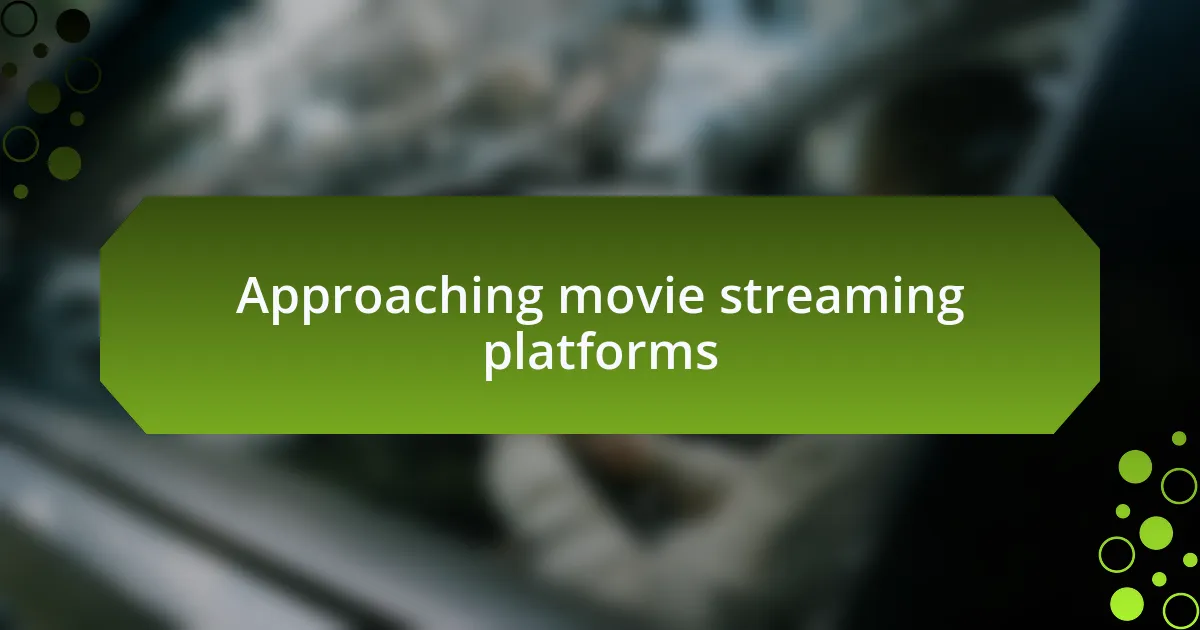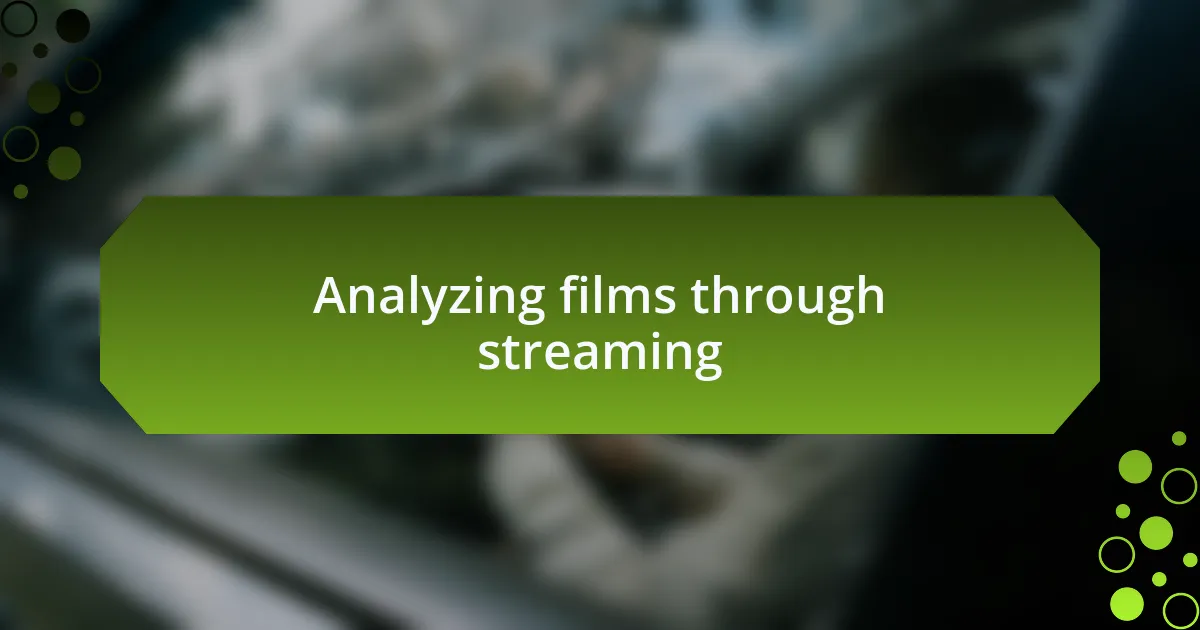Key takeaways:
- Primary and secondary sources, including personal accounts and film community discussions, enhance understanding of film history.
- Online databases and specialized resources, such as film journals and archives, are crucial for research.
- Streaming platforms offer unique opportunities for deeper film analysis through curated collections and supplementary materials.
- Engaging with social media and online forums can provide fresh perspectives and foster a sense of community in film research.

Understanding film history research methods
When diving into film history, I often start by exploring primary sources, such as original scripts, studio archives, and interviews with filmmakers. These materials give me a visceral connection to the industry during its pivotal moments. Have you ever stumbled upon a behind-the-scenes story that completely changed your perception of a film? Finding those gems can unlock so much understanding about the artistic choices made.
Secondary sources like scholarly articles and books are invaluable too, but I find that personal accounts often resonate the most. I remember reading an old filmmakers’ biography that detailed their struggles with censorship. It allowed me to appreciate not just the film itself but the socio-political context surrounding its creation. How can we fully celebrate a classic without understanding the challenges its creators faced?
Finally, I find that engaging with film communities, whether through forums or film festivals, adds another layer to my research. Speaking with fellow enthusiasts often reveals unique perspectives that challenge my views. Have you ever had a conversation about a film that changed your entire understanding of it? I certainly have, and those discussions remind me that film history is a living, breathing dialogue.

Resources for film history research
When it comes to film history research, I often turn to online databases and digital archives. Websites like the American Film Institute Catalog and the Library of Congress provide a treasure trove of information. I remember the thrill of uncovering a long-lost film through a searchable database; it was like finding a hidden gem in a vast ocean of content. Have you ever clicked on a link that opened up a whole new world of cinematic history?
Books and journals specializing in film studies are another crucial resource in my journey. I vividly recall pouring over a collection of essays that discussed the evolution of genre films. Each chapter was like peeling back layers of an onion, revealing the influences that shaped filmmaking. Just think about it—how much deeper can our appreciation go when we understand the intricacies behind our favorite genres?
Lastly, attending lectures or Q&A sessions with film historians can be incredibly enriching. There was a time when I attended a seminar on silent cinema, and the insights shared by the speaker sparked my curiosity in ways I hadn’t anticipated. Have you ever left a talk feeling inspired to explore a new facet of film? Those moments can ignite a passion that leads to more profound research and understanding.

Tools for effective film research
One of my go-to tools for film research is specialized software that can organize and manage extensive data efficiently. I once used a program designed for film scholars that allowed me to tag and sort films by various parameters such as director, era, and genre. Honestly, it was a game changer—having everything neatly organized made it so much easier for me to connect themes and trends across different periods. Have you ever found a tool that simplified a complex task for you?
Additionally, social media platforms have surprisingly become a rich source of information in the film research landscape. I remember following film historians and critics on Twitter, where they share daily insights, articles, and even anecdotes from their research journeys. Engaging with their posts often leads me to new discoveries or prompts me to think more critically about films I thought I knew inside out. Isn’t it fascinating how a single tweet can spark a whole new research angle?
Then there’s the power of online communities and forums dedicated to film enthusiasts. I once joined a discussion group focused on classic Hollywood cinema, and the debates were both lively and enlightening. Through sharing opinions and resources with others who share the same passion, I gained new perspectives and unearthed obscure films that I may never have encountered otherwise. Have you experienced that sense of camaraderie that makes research feel more like an adventure?

Approaching movie streaming platforms
When approaching movie streaming platforms, I’ve found that browsing their curated collections can be both enjoyable and thought-provoking. I distinctly remember discovering a “Director Spotlight” section that introduced me to films I had overlooked in the past. Has there ever been a moment when a simple recommendation changed your perspective on a filmmaker?
Moreover, the user interface of streaming platforms can greatly influence how I engage with films. I once tried a platform that featured a personalized recommendation algorithm, which led me to watch obscure foreign films that I might have otherwise ignored. It was exhilarating to see how these unexpected choices expanded my understanding of global cinema. Isn’t it amazing how technology can guide us toward hidden gems?
Lastly, I always check out the special features available on these platforms, such as director commentaries and behind-the-scenes documentaries. I remember watching one such documentary that explored the creative process behind a cult classic. It not only deepened my appreciation for the film itself but also made me ponder the intricate balance of art and commerce in filmmaking. Have you ever explored the layers of a movie beyond its surface?

Analyzing films through streaming
Streaming platforms offer a unique lens through which I can analyze films on a deeper level. For instance, when I watch a classic film alongside its streaming counterpart, I often find myself toggling between the movie and supplementary materials like production notes. This layering truly enhances my viewing experience, prompting me to ask: how much context do we really need to appreciate a film fully?
What I particularly enjoy is how streaming services often provide access to different versions of the same film, whether it’s a director’s cut or a remastered edition. I recall watching the extended version of a beloved epic and discovering entire subplots I had previously overlooked. It was as if I was experiencing the film anew, which raises the question: does greater access to content change our perception of cinematic storytelling?
I also utilize the social features embedded in streaming platforms, like discussions or reviews from fellow viewers, to deepen my understanding of a film’s themes. Engaging with others about a movie I just watched often leads me to insights I hadn’t considered. Have you ever found a single conversation about a film alter your entire interpretation of it? For me, those exchanges transform film-watching into a communal exploration of art.